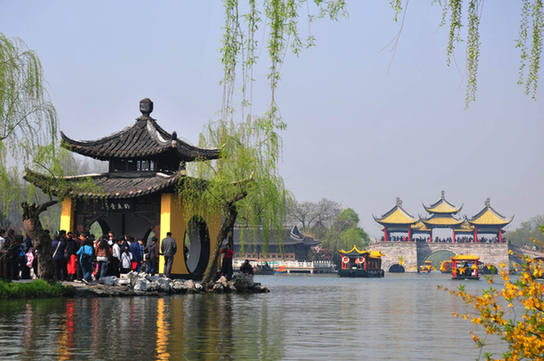|
Yangzhou Amid the Willow Blossoms
 |
| The Slender West Lake in spring |
The name of a city can often conjure up memories of poetry, people or flowers. Yangzhou is such a city, as demonstrated by the famous Tang poet Li Bai in his Seeing off Meng Haoran for Guangling at Yellow Crane Tower:
My old friend said goodbye to the west
here at Yellow Crane Tower.
In the third month’s cloud of willow blossoms
he is going down to Yangzhou.
The lonely sail is a distant shadow
on the edge of a blue emptiness.
All I see is the Yangtze River
flow to the far horizon.
The poem captures the beautiful scenery of Yangzhou in spring, the third month referring to the Chinese lunar calendar, which approximates to April on the Gregorian calendar.
Yangzhou is in central Jiangsu Province in East China. Culturally it is classified as ''typical culture south of the Yangtze River (Jiangnan)'' even though it actually lies north of this great artery.
The term '' Jiangnan'' refers to the areas in the middle and lower reaches of the Yangtze River with a developed economy and culture of prosperity. Historically Yangzhou was a city famous for its flourishing society.
Spring is the best time to visit Yangzhou and is also the peak tourist season. Every year on April 18 Yangzhou launches a month-long Flowery Third Month International Trade and Tourism Festival. It is a time of year when moist mists cloak the city and its emblematic flower – the snow viburnum – is in full bloom, flooding the air with its heady fragrance.
''Most of the Gardens Are Residences''
Yangzhou has a recorded history of nearly 2,500 years. Following the excavation of the Grand Canal in the seventh century, Yangzhou became the intersection of the Grand Canal and the Yangtze River. It served as an important traffic hub in southern China, essentially an inland entrepôt. By the mid-18th century, more than 100,000 merchants lived here, making it one of the most important commercial centers in southern China.
Northern Jiangsu was a major salt producer, so, to facilitate commerce in salt, the national salt administration center was set up in Yangzhou. As a result, most of the Yangzhou merchants were salt dealers. After cereals and fabrics, salt ranked third among bulk goods on the Chinese market. The salt trade was a state monopoly, producing tax revenues accounting for one-fourth of the total national revenue. No other city could compare to Yangzhou in this regard. Salt trade profits were very high, and the salt merchants the richest people in this wealthy city.
These nouveau riche families firmly believed in the notion ''If you' ve got it, flaunt it!'' They liked to go one better than their neighbors, particularly in the construction of gardens and pavilions, and this helped stimulate the development of landscaped scenery in Yangzhou. Most of the landscape gardens were built by tycoons; in fact there's a Yangzhou saying: ''Most of the landscape gardens are residences.'' Those that survive today were private homes, the famous ones include the Lu Family Mansion, Geyuan Garden, Wang’s Garden and Heyuan Garden.
A cluster of tall buildings at 22 Kangshan Street is the Lu Family Mansion, known as ''No. 1 building of salt merchants.'' Built in the late 19th century, it was the largest of the salt-dealer mansions, a luxurious residence owned by Lu Shaoxu, a salt tycoon. The residence occupies more than 10,000 square meters. One enters via a south-facing gateway whose carved-brick lintel depicts various lifelike figures. In all, the mansion comprises nine courtyards, with more than 200 rooms, and the main central court is lined with small gardens, with rockeries and plants in different compositions. The whole mansion is tastefully laid out and luxuriously furnished. Unfortunately, the best parts were damaged in two fires and the present mansion is largely a replica of the original design: the only original elements surviving that testify to the tycoon's wealth are the gate tower, one residence, the Yiyuan Garden and the Library.
Geyuan Garden in northern Yangzhou is the best-preserved classic garden with the longest history and greatest artistic value. The name merits some explanation: it is an auditory and visual play on words, linking elements in the owner's given name that means bamboo (in which the garden abounds) and the pointed shape of the bamboo leaf that resembles the Chinese character ''Ge'' (个). Geyuan Garden is a classic private garden-like residence. Within its modest dimensions there are four seasonal theme areas: spring, summer, autumn and winter. The rocks and bamboos in each area are quite special, full of poetic charm. It is unique among Chinese gardens.
The owner of Heyuan Garden was He Zhike, who served as China's Minister Counselor to France during Qing Emperor Guangxu's reign (1871-1908). It was the last large garden to be built in Yangzhou under dynastic rule, and is a marvel of Chinese garden-making. It incorporated the good points of various other gardens as well as Western architectural elements, and pioneered new building materials. This was the last architectural masterpiece of its kind in Yangzhou before its salt trade went into decline and garden art shifted to Suzhou.
| 